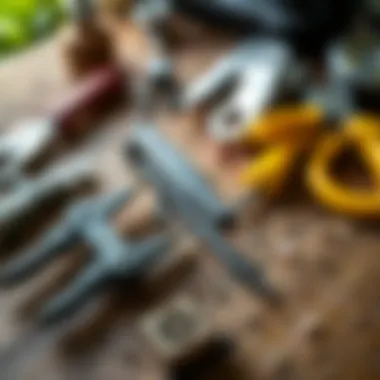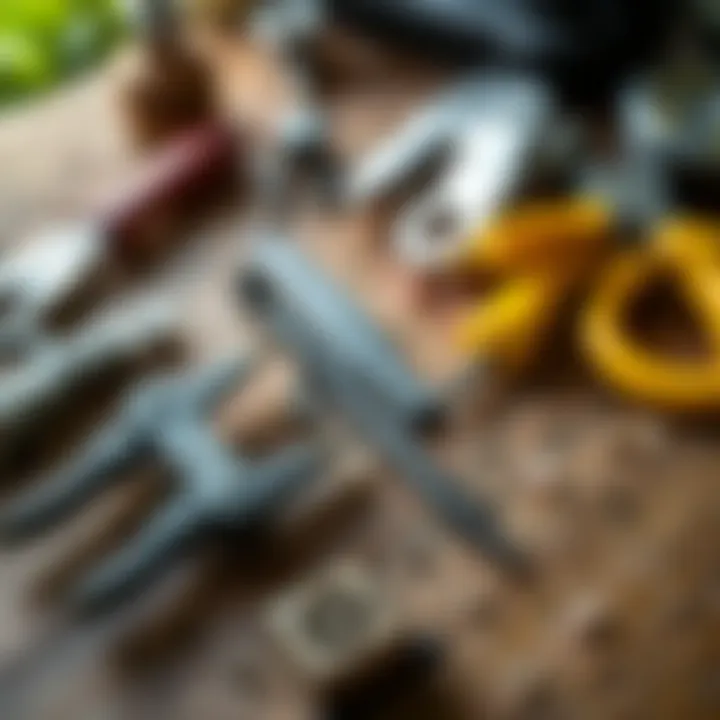Patching Mouse Holes: Effective Strategies and Tips


Intro
Patching up mouse holes might seem like a straightforward task, yet it’s wrapped in layers of complexity. While some might think of it as just sealing the entry point, the entire process involves understanding what attracts these critters, how to effectively block their paths, and what steps should be taken afterward to avoid a repeat of the scenario.
Let’s break down the journey into three main sections: Pest Identification, Prevention Strategies, and Treatment Options. Each of these plays a significant role in ensuring that your home remains a sanctuary free from unwanted visitors. By the end of this exploration, you will have a robust methodology not only for patching but also for keeping your home secure against future invasions.
Pest Identification
Detailed Descriptions of Common Pests
When we think about pests, how many of us truly know what lurks in our walls? Mice, particularly the house mouse, deer mouse, and field mouse, are small, yet they can leave significant damage and health hazards in their wake. These rodents can quickly multiply, and before you know it, a couple of mice can turn into a full-scale infestation.
House mice are typically grayish-brown with a lighter underbelly, around 2.5 to 4 inches long. They tend to come out at night, foraging for food, while deer mice have a more diverse coloration and are often found in rural areas. Understanding these distinctions aids in recognizing what you are dealing with inside your home.
Signs and Symptoms of Infestations
If you suspect a mouse has made itself at home, here are some common signs to watch for:
- Droppings: Tiny, dark pellets often found in cupboards or along walls.
- Gnaw marks: On food packaging, furniture, or baseboards—indicative of a hungry pest.
- Nests: Shredded paper, fabric, or insulation, piled up in corners or hidden spaces.
- Sounds: Scratching or scurrying noises coming from walls or ceilings during the night.
Recognizing these signs early can save you from a costly and extensive cleanup process.
Prevention Strategies
Home Maintenance Tips for Pest Prevention
Prevention is always better than cure, or so they say. Regular home maintenance can play a pivotal role in deterring mice from making a beeline for your living space. Start by sealing any cracks or gaps around windows, doors, and even the foundation. Ensure that screens are intact and, if you love gardening, keep shrubs and plants at least a foot away from the walls.
- Keep food stored securely: Invest in airtight containers for pantry staples.
- Reduce clutter: Mice are experts at finding hiding spots within a disorganized environment.
- Monitor moisture levels: Repair any leaks that might attract rodents seeking water.
Natural Deterrents and Barriers
If you’re leaning towards more eco-friendly options, consider using natural deterrents. Essential oils like peppermint and eucalyptus have shown promise in discouraging mice. Spraying a solution created from these oils at entry points can work wonders.
Treatment Options
Overview of Chemical vs. Natural Treatments
Once you’ve identified an infestation, the next step is deciding how to treat it. Chemical sprays and traps often promise fast results, while natural options focus on humane methods. The choice depends largely on where you stand on such matters. Chemical methods might be effective, but they come with potential risks, especially if pets or children are around.
Step-by-Step Guides for DIY Treatments
For those inclined to take matters into their own hands, here’s a straightforward way to tackle the issue:
- Set up snap traps: Bait with peanut butter or sunflower seeds, which are irresistible to mice.
- Use a sealing agent: After removing any captured mice, patch the entry point with a sturdy material like steel wool or silicone sealant.
- Maintain cleanliness: Regularly check for droppings and signs of re-entry to catch any potential stragglers.
By understanding mouse behaviors and taking proactive measures, you can secure your home against these unwelcome guests.
The End
Overall, patching mouse holes is multifaceted, requiring a blend of proper identification, preventative measures, and treatments. Each step reinforces your home’s defenses while ensuring a cleaner, safer living environment.
Understanding the Importance of Patching Mouse Holes
When it comes to maintaining a comfortable living environment, few issues can disrupt the peace quite like a mouse infestation. Understanding the importance of patching mouse holes is crucial not just for the immediate discomfort these critters can cause, but for the broader implications on health and property integrity.
One of the primary reasons to address mouse holes promptly is the potential health risks associated with rodent infestations. Mice can carry diseases, such as hantavirus and leptospirosis, which can pose serious threats to humans. The idea of sharing your space with these unwelcome visitors can be unsettling, but the risks are tangible and should not be dismissed lightly.
Moreover, mice are relentless in their search for food and shelter, which often leads them to chew through wires, insulation, and walls, causing structural damage. This can lead to costly repairs down the line—a prospect that nobody wants to face. Effectively patching these holes is not merely an act of immediate defense; it is also a proactive step in safeguarding your property and finances in the long run.
Understanding where mice hide and how they enter homes—often through tiny cracks or openings—is vital. Patching these entry points knots up the odds against recurring infestations. By effectively sealing these vulnerabilities, homeowners can prevent future mouse incursions. This, in conjunction with proper sanitation and environmental modifications, creates a less inviting atmosphere for these pests.
Not only does patching holes help in pest control, but it also enhances the overall aesthetics of your space. An unattended mouse hole can be an eyesore, drawing unnecessary attention and potentially decreasing property value. After all, who wants a home that appears to be an open invitation for rodents? As we continue exploring effective methodologies for patching mouse holes, remember that each step taken towards prevention is a step taken towards a healthier, more secure living environment.
"A stitch in time saves nine," they say, and this adage holds particularly true when it comes to mouse control.


The Mouse Problem and Its Implications
The concept of mouse problems is not just a pest control concern; it's a matter that affects the quality of life. When mice invade a home, they bring with them potential health risks, damage to property, and a sense of unease that can linger long after the unwanted guests have been eliminated. Mice reproduce rapidly, and a small issue can quickly spiral into a full-blown infestation if not managed effectively.
Think about it this way: a mouse is not a lone wolf. They travel in family groups, leading to a rapid increase in population. Hence, what may start as a simple patch could turn into a race against time if the problem persists. Homeowners must take the initiative to close the door on these pests before they make themselves too comfortable.
Common Locations for Mouse Holes
Knowing where to look for mouse holes can save precious time and effort. Mice are crafty little animals that commonly exploit areas around a household that may appear innocent at first glance. Here are some usual suspects to investigate:
- Basements: Poorly insulated basements are prime real estate for mice. Look for gaps in foundations or around pipes.
- Kitchens: Food sources attract mice, making kitchens a likely location for holes. Check behind appliances and cabinets.
- Attics: Mice often find their way to attics, so inspect corners and areas near ventilation.
- Garages: If you store items in your garage that may have been used outdoors, be alert for holes near external walls.
Identifying these common hotspots can better prepare homeowners for a systematic approach to patching and prevention. By being vigilant and patching promptly, you fortify your home against future infestations.
Identifying Mouse Holes
Identifying mouse holes is a pivotal step in dealing with rodent infestations. For homeowners, knowing how to spot these entry points can prevent costly damage and health hazards associated with rodents. Mice can squeeze through holes as small as a dime, making it crucial to be vigilant. Understanding how to identify holes not only aids in the immediate task of patching but also highlights the areas of a structure that may need further inspection and fortification.
Physical Signs of Infestation
Detection of mice begins with observing physical signs around your home. Here are some critical indicators:
- Droppings: Mouse droppings resemble small black rice grains. Finding them near food packages or hidden corners suggests they may have made themselves at home.
- Gnaw marks: Pay attention to any signs of gnawing on wood, electrical wires, or walls. Mice tend to leave tooth marks on various surfaces, indicating they’re searching for food or nesting material.
- Nests: Mice build nests from shredded materials. Look in hidden spots such as attics or basements where debris might accumulate.
Besides these physical signs, sounds can also betray their presence. Scratching noises in the walls or ceilings, especially at night, might be a clear signal that a family of mice resides nearby.
Assessing Structural Vulnerabilities
To effectively identify and patch mouse holes, it’s imperative to assess any structural vulnerabilities in your home. Here’s how:
- Inspect the Foundation: Examine the perimeter of your home. Look for cracks or gaps in the foundation. Even the tiniest fissure can be an entrance point for mice.
- Check Around Pipes: Mice often enter homes through gaps around water pipes and utilities. Ensure that these areas are well-sealed.
- Windows and Doors: Inspect door frames and window screens for gaps. If there's enough space for a mouse to wiggle through, it’s advisable to reinforce these areas.
- Attics and Crawl Spaces: Don’t overlook seldom-seen areas. Attics and crawl spaces can be breeding grounds for mice if not properly checked on regularly.
Remember: Identifying holes not only aids in an immediate response but helps in long-term prevention strategies. It may be worthwhile to take photographs for documentation or to help contractors pinpoint issues during repairs.
Once you've completed an assessment, you’ll be better equipped to patch and prevent future incursions effectively. Monitoring these signs of potential vulnerabilities regularly can save time, trouble, and money in the long run, making it a wise investment for your home.
Choosing the Right Materials for Patching
Choosing the right materials for patching mouse holes is a pivotal step in mouse control. When faced with a rodent problem, using the appropriate materials can make the difference between a temporary fix and a lasting solution. Mice can chew through countless substances, so it’s crucial to select materials that withstand their determined efforts. Not just that, these materials must be durable and suitable for the location of the patch. Choosing poorly can result in rodents returning with a vengeance, leading to further infestation, damage, and expenses.
Key considerations include:
- Material Compatibility: Depending on where the hole is located, the material needs to be compatible with the surrounding environment. For example, a patch in a damp area may require a moisture-resistant material.
- Cost: Balancing budgetary constraints with the effectiveness of the materials is essential. Sometimes, spending a bit more can save a lot in the long run.
- Ease of Installation: If you plan on doing it yourself, choose materials that are not overly difficult to handle or install.
Overall, these factors contribute to ensuring that your efforts in patching are not in vain.
Types of Materials Utilized
Various materials are commonly used when patching mouse holes, each with its own strengths. Here are some of the more popular options:
- Steel Wool: A favored choice for small holes. Mice dislike chewing through it, and it’s great for sealing gaps in walls and floors.
- Caulk: When applied correctly, caulk can create a strong seal. It’s generally easy to work with and effective for sealing cracks.
- Wooden Plugs: Especially for larger openings, wooden plugs can be fitted into the hole and then sealed with a strong adhesive.
- Metal Mesh: This is mostly used for larger holes in areas that may be vulnerable. It’s difficult for mice to chew through.
- Concrete: If you have a hole in a foundation, concrete can provide a robust solution, although it may require additional materials like a bonding agent for proper adhesion.
When selecting a material, consider its properties relating to both durability and effectiveness in thwarting curiosity-driven rodents.
Evaluating Material Durability
Assessing the durability of your chosen patching material is vital. Not all materials are created equal, and their longevity can vary significantly:
- Resistance to Chewing: Materials like steel wool and metal mesh offer natural resistance, while softer options like foam may not last against a determined mouse.
- Weather Resistance: If the location is exposed to moisture, the durability of the material becomes even more critical. Caulking may hold up well indoors but might deteriorate outside due to rain or snow.
- Longevity Under Stress: Over time, even a well-installed patch can be tested by settling foundations or vibration. Regular maintenance checks are recommended to reassess durability.
- Cost vs. Performance: Sometimes a higher price tag correlates with better performance. Investing in high-quality materials may save time and hassle in the future.
"Choosing the wrong material can turn a one-time effort into a recurring nightmare. Make informed choices!"
Regular evaluations of your patch material will help maintain a mouse-free environment and ensure longevity in your repairs. The effectiveness of your patching approach directly reflects on the choice of materials you select.
For more detailed insights on pest control and mouse behavior, consider checking out resources from organizations like CDC.gov, University of California Agriculture and Natural Resources, or explore community experiences on Reddit.


Tools Required for Patching Holes
Patching mouse holes is not just about blocking a tiny gap; it's a proactive measure to secure your home from pesky invaders. The right tools are crucial in determining how effective your patching effort will be. With every hole representing a potential entry point for rodents, having an arsenal of specific tools fine-tunes your approach and ensures a comprehensive job. Beyond the basic requirements, polished execution needs the right hand tools and sealants tailored to each situation.
Essential Hand Tools
When it comes to the basics of patching, hand tools are your best friends. Although one might think a hammer and nails could suffice, there's a variety of other tools that streamline the process. Here are some tools you'll most likely need:
- Utility Knife: Ideal for cutting materials accurately, ensuring a smooth fit. A sharp blade will save a lot of hassle.
- Screwdrivers: Both Phillips and flathead options are necessary to remove any grommets or plates that may be blocking your work area.
- Pliers: For gripping and twisting; they make handling wire mesh or any other tough materials a breeze.
- Adhesive Spreader: If you're using paste or any liquid adhesive, a spreader will distribute it evenly.
- Putty Knife: Useful in applying and smoothing out patching compounds or fillers.
Each one comes into play, depending on where the hole is situated. You may neep to consider your own DIY skills when deciding if you should patch the hole yourself or call in a pro. A little elbow grease paired with the right tools can ensure a tight seal that keeps mice out.
Commonly Used Sealants
Sealants are the unsung heroes when it comes to creating a barrier against mice. They can be used in conjunction with other patching materials to create a robust and durable finish. Here’s a look at some popular choices:
- Steel Wool: Often the go-to for smaller gaps, rodents find it challenging to chew through. It can be packed tightly in holes.
- Expanding Foam Sealant: This foamy substance can fill large crevices and is effective at preventing water and air passage.
- Silicone Caulk: A flexible and waterproof choice, great for sealing up gaps around pipes or baseboards.
- Concrete Patch: For larger holes, particularly in foundations and masonry, concrete patch provides strength and durability.
Choosing the right sealant isn't only about effectiveness, each has its unique use-case scenario. Factors like the hole size, location, and environmental elements all come into play.
"Sealants not only fill holes; they fortify your home against potential infestations, ensuring long-term peace of mind."
All in all, proper tools not only enhance the execution but also play a significant role in determining how long your patch holds up. In a game of wits against these cunning little creatures, being prepared is half the battle.
Step-by-Step Guide to Patching Mouse Holes
When faced with the nuisance of mouse holes in your home, knowing how to properly patch them is a critical element in maintaining a pest-free environment. This section aims to provide a systematic approach to effectively seal these entry points, ensuring that your home remains secure against future infestations. By following the steps outlined below, homeowners can tackle this issue with confidence and practicality, thereby protecting their property and peace of mind.
Preparation Phase
Before diving into the actual process of patching, a well-planned preparatory stage is essential. This stage sets the groundwork for success. Start by gathering all necessary materials and tools. Light is key here; proper illumination will help you identify every nook and cranny that might need attention.
Key tasks in the Preparation Phase include:
- Inspecting the Area: Look for mouse holes, signs of gnawed materials, droppings, or trails.
- Selecting Appropriate Patching Materials: Depending on the size and location of the holes, choose from a variety of materials, such as steel wool, wood, foam, or specific rodent-proof sealants. This choice will significantly impact the effectiveness of your patch.
- Safety Gear: Don’t forget to wear gloves and a mask to protect yourself from allergens or contaminants that may be present in mouse droppings or nesting materials.
- Clearing the Surrounding Area: Keep the workspace tidy. Remove any furniture or obstacles in proximity to ensure easy access and to avoid mishaps.
Applying the Patch
Once you have everything in place, it's time to start applying the patch. Precision during this phase cannot be overstated. This step can make or break your efforts in sealing off those annoying entry points.
Steps to effectively apply the patch:
- Clean the Hole: Remove debris and loose materials around the hole. A clean surface allows for a better bond with the patching material.
- Insert Filling Material: For smaller holes, packing steel wool tightly into the hole is often a good choice, as mice struggle to gnaw through it. For larger gaps, consider using foam or wood, ensuring a snug fit.
- Seal the Patch: Apply your chosen sealant or filler over the patch material to create a strong and impenetrable barrier. Make sure to cover all edges thoroughly.
- Check for Gaps: After applying, inspect the area to ensure that there are no voids left uncovered. Any small openings can invite mice back into your home.
"A stitch in time saves nine." Taking care of these small holes promptly helps prevent bigger problems down the line.
Finishing Touches and Inspection
After the patch is applied, there are a few last-minute checks you should conduct. These finishing touches enhance durability and reinforce your mouse-proofing efforts.
- Inspect for Evenness: Make sure the patch sits flush with the surrounding surface. Uneven patches can attract attention from lingering rodents.
- Clean Up: Dispose of any waste or unused materials safely.
- Visual Inspection: Conduct a thorough check of the patched area. Look for any signs of deterioration or gaps that may emerge after the patching material has settled.
- Documentation: If you’re keeping track of areas patched, note the date and materials used. This will help you maintain an efficient pest control schedule.
By systematically addressing each stage of the patching process, homeowners can create a formidable barrier against these unwanted guests, ensuring peace of mind and security in their homes.
Preventive Measures Against Future Infestations
Taking a proactive approach to manage mouse populations in your home can save you a heap of trouble down the line. Preventive measures not only protect your space but also ensure your sanity. While patching holes addresses immediate access points, it’s crucial to look at broader strategies that keep those pesky critters from knocking at your door again. Understanding the importance of preventive measures means recognizing their role in the overall pest management game plan.
Environmental Modifications
Modifying the environment around your home is one of the first lines of defense against mouse infestations. Mice thrive in spaces that offer cover and access to food; therefore, alterations to their habitat can significantly reduce their presence.
- Seal Off Entry Points: Ensure all potential access points are sealed. Even the smallest cracks or gaps can become tunnels for mice. Use steel wool or caulk to fill these openings; it’s a simple yet effective method.
- Landscaping Adjustments: Trim back shrubs, bushes, and trees that are too close to your home. Mice are crafty; they can easily climb branches and jump onto roofs or enter through second-floor windows. Keeping shrubs short minimizes their hiding spots.
- Strategic Mulching: If you use mulch, opt for cedar or other woody mulches, as they can deter mice. Avoid using straw or other materials that might offer a cozy nesting area.
- Storage Solutions: Store firewood well away from the house and on raised platforms to deter mice from nesting. Mice like to hide in woodpiles.
These modifications create an environment less conducive to a mouse infestation. It’s like rolling out the red carpet for peace of mind.


Proper Sanitation Practices
You might think cleanliness is next to godliness, but when it comes to rodents, it’s downright essential. Proper sanitation removes food and nesting sources, making your home less inviting for mice.
- Food Storage: Store all food in airtight containers. Mice can sniff out crumbs and leftovers with incredible accuracy. By denying them even a nibble, you’re taking a huge step toward keeping them at bay.
- Regular Cleanups: Regular vacuuming and sweeping reduce crumbs and nesting material, which can keep the population low. Pay extra attention to areas that might be overlooked, like behind appliances and under furniture.
- Waste Management: Secure trash bins with tight-fitting lids. Unsecured waste is like a buffet invitation for mice. Make it a habit to take out the trash regularly, especially if it contains food waste.
- Pet Food Precautions: Don’t leave pet food out overnight. It may attract not only your furry friends but also their unwanted rodent counterparts.
By implementing these sanitation practices, you are proactively creating a clean slate. It becomes a twofold victory: maintaining your home while thwarting mice.
"An ounce of prevention is worth a pound of cure." This old saying rings especially true when it comes to pest control. Investing time and resources into preventive measures can save homeowners a significant amount of time and money in the long run.
Monitoring and Maintenance After Patching
Once you have patched the mouse holes, the task isn't entirely over. Regular monitoring and maintenance are vital to ensuring that your efforts bear fruit in the long run. After all, it’s one thing to plug those pesky entry points, but an entirely different ball game if mice decide to show up again. Here we delve into the specifics of why this ongoing vigilance is crucial and what actions you should integrate into your routine.
Regular Inspections
Carrying out inspections on a consistent schedule can’t be emphasized enough. The idea is to keep a watchful eye for any signs of renewed rodent activity. Remember, mice are crafty little creatures; they can squeeze through incredibily tiny openings if they’re motivated enough.
Here are factors to keep in mind:
- Frequency: Aim for inspections at least every few weeks, particularly in warmer months when mice are most active.
- What to Look For: Be on the lookout for gnaw marks around patched areas, fresh droppings, or shredded materials in corners—these are often tell-tale signs that your patching efforts may need another look.
- Using Tools to Help: Some homeowners find it useful to employ a flashlight and a can of compressed air for hard-to-reach areas. The air can dislodge any cobwebs or debris that could hide rodent traces.
"The key to preventing mice is staying ahead of the curve, rather than playing catch-up after they've re-emerged."
Timing for Reassessment
While regular inspections keep your defenses strong, knowing when to reassess the effectiveness of your patches is equally important. This reassessment might not be as frequent as inspections, but it carries its own set of considerations. The timing can vary according to several elements:
- Seasonal Changes: In colder months, mice often seek shelter, increasing the need to reassess. Examine the integrity of patches as the weather turns chilly, as these entry points could become more appealing for rodents.
- Pest Activity Signs: If you notice signs of renewed pest activity during your inspections, consider this a cue to reassess your patching strategies. Don’t assume it’s a fluke; it’s wise to double-check your work.
- Structural Changes in Home: Any major repairs or renovations could affect the status of your patches. For instance, if you’ve had plumbing or electrical work done, it’s advisable to inspect mouse entry points again as these activities can disturb the integrity of barriers you’ve put in place.
Considerations for Professionals in Pest Control
When it comes to patching mouse holes, pest control professionals carry a unique weight of responsibility. They not only address immediate concerns but also develop strategic, long-term solutions necessary for keeping rodents out. Understanding the complexities of mouse behavior, habitats, and the potential damage they can cause is crucial.
Specific Elements to Consider
Firstly, professionals must evaluate a property thoroughly. This means carefully inspecting structural vulnerabilities and identifying where mice might be entering. Often, the ‘can do’ attitude is half the battle. To completely combat a mouse issue, knowledge of the local environment also plays an important role. Factors such as food sources, water availability, and even neighboring properties can influence mouse behavior.
Benefits for Homeowners
For homeowners, engaging professional services often translates to faster resolutions. Pest control experts utilize advanced techniques that many laypersons might overlook. For example, they may apply baiting methods along key pathways to determine how extensive the infestation could be. Moreover, professionals possess a toolkit of methods that go beyond just patching holes, integrating holistic approaches that emphasize preventative measures.
"Going in blind can leave homeowners with unresolved issues, while professionals can provide a clearer assessment and more effective solutions."
Advanced Techniques for Large Infestations
When faced with large infestations, professionals pull out all the stops. They might use a combination of traps and baits to reduce mouse populations before patching holes. This strategic approach is key; addressing the infestation first means that the newly patched areas will not be compromised soon after the work is done.
Some advanced techniques may include:
- Exclusion Measures: This involves sealing off potential entry points with durable materials, ensuring that once the job is complete, it stays that way.
- Fumigation and Gas Treatments: These methods can be effective in larger structures where traditional bait methods may seem inadequate.
- Environmental Adjustments: Often overlooked, modifying the mouse's habitat can significantly reduce future infestations. This may involve relocating outdoor garbage bins or employing landscaping changes to deter mice from entering structures.
Consulting with Experts
Consultation with experts is not just a last-minute thought; it can be an essential step. Professionals in pest control often undergo specific training and stay abreast of the latest trends in pest control technology and science. The discussions that stem from consulting with experts can enrich the pest control strategy for homes and businesses alike.
Benefits of Working with Experts
- They provide insights based on experience, enabling better choices than trial and error methods.
- They help assess the situation more accurately and develop a tailored approach for dealing with mouse holes.
- Often, they can recommend sustainable practices that minimize risks to human health and the environment.
Finale: Ensuring Long-Term Mouse Control
In the battle against unwanted rodents, it is crucial to have a well-thought-out strategy that goes beyond just patching up holes. The process of sealing mouse entry points must be seen as part of a broader approach to maintaining a mouse-free environment. By integrating effective patching with ongoing monitoring and preventive measures, homeowners can significantly reduce the risks associated with mouse infestations.
A significant aspect of achieving long-term mouse control is understanding the behavior and habits of these creatures. Mice are formidable survivors; they can slip through the tiniest of gaps. Once inside, they reproduce quickly and cause considerable damage. Therefore, it is not just about addressing the current situation but also preventing future problems. Effective mouse hole patching isn’t merely a remedial action; it is a long-term commitment to maintaining the integrity and safety of your home.
"Creating a proactive environment helps ensure that your home remains not just mouse-resistant, but mouse-proof."
Recap of Key Points
- Understanding of the Severity of Infestations: Acknowledging that one small hole could potentially lead to an entire family of mice entering your home is vital. Mice do not need much space to make an entry.
- Identifying Structural Vulnerabilities: Homeowners should routinely assess their properties for signs of wear and tear that could lead to potential entry points for rodents.
- Selecting Proper Materials: Choosing durable materials for patching is essential. Options such as galvanized steel mesh or high-quality sealants should be preferred over temporary fixes like tape.
- Monitoring and Maintenance: Regular inspections of patched areas and the overall environment play an important role in ensuring that the patched holes remain secure over time.
- Environmental Management: Implementing changes to eliminate food sources and nesting areas goes hand-in-hand with patching methods.
Final Recommendations
- Conduct Routine Checks: Schedule inspections every few months to identify new vulnerabilities that may arise. This proactive approach allows you to catch issues before they escalate.
- Keep an Eye on Hazardous Areas: Pay special attention to spots like basements, attics, and around utility lines—they can often be overlooked but are likely places for mice to gain access.
- Educate Your Household: Everyone should be aware of what to look for. Keeping children informed about the signs of mice can be helpful.
- Seek Professional Help When Needed: If the infestation is extensive, bringing in pest control experts can be beneficial. Their knowledge and tools can help in managing larger problems.
- Combine Approaches: Use the methods discussed in this article to create a comprehensive barrier against rodents, integrating patching strategies with sanitation practices and environmental modifications.
By adopting these practices, homeowners can enjoy peace of mind, knowing they are taking diligent steps toward maintaining a rodent-free sanctuary.



